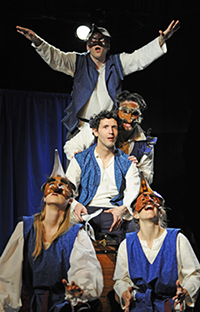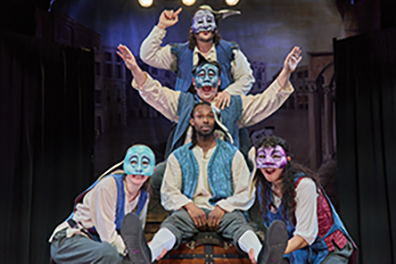A Commedia Romeo and Juliet
Fools Revisit a Landmark Production
Faction of Fools, Capitol Hill Arts Workshop, Washington, D.C.
Saturday, January 20, 2024, Sixth row and first row
Directed by Kathryn Zoerb
One of my great rewards doing Shakespeareances has been experiencing the connection between William Shakespeare and commedia dell’arte, the masked and hyperphysical street theater tradition that originated in early 16th century Italy. I owe this discovery to the Washington, D.C., Faction of Fools, theater company and their landmark 2012 production of A Commedia Romeo and Juliet.
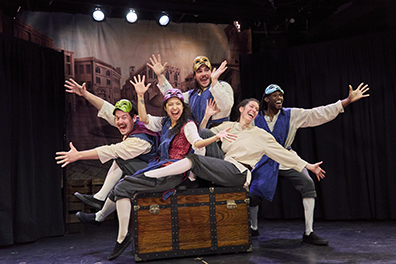
The "Capulet Cast" enters on a rolling trunk at the start of Faction of Fools' remount of their 2012 A Commedia Romeo and Juliet at the Capitol Hill Arts Workshop in Washington, D.C. William Shakespeare's play was originally adapted by Mattheew R. Wilson and Paul Reisman, and the remount adapted by Kathryn Zoerb and Matthew Pauli. From left are Ben Lauer, Bri Houtman, Robert Pike, Natalie Cutcher, and Travis Xavier Brown. Photo by DJ Corey Photography.
The images of that production have romped through my memory ever since and returned in present flesh as Faction of Fools remounted the show at the Capitol Hill Arts Workshop in January. There was Queen Mab’s chariot represented in the persons of all five cast members turning Mercutio’s description of the fairy midwife’s dream journey into a visual wonder. There was the not-dead-yet Juliet being tossed about by her oh-woefull parents, nurse, and would-be husband. There were the antics and acrobatics of Mercutio’s and Tybalt’s posses trying to keep the two combatants from hurting each other; and then the single thrust instantly silencing the belly laughs that had filled the theater. In the subsequent silence, you could make out heartbeats as Mercutio died like no other Mercutio could. Then came the real stunner.
The production, the centerpiece of the company's 15th anniversary season, is more rebirth than revival, as it has been fine-tuned, trimmed (the hour-long show is 20 minutes shorter than the original), and features a new approach to masks designed by Tara Cariaso of Waxing Moon Masks. Nevertheless, the commedia masking and archetypal physicality and how both inform Shakespeare’s text and vice versa remain the production’s calling card. As the Capitol Hill Arts Workshop run ended February 3, the show began a tour of local schools: students get a condensed version of Shakespeare’s most studied play and an introduction to the Italian theater tradition that influenced him.
For purposes of touring logistics, the show has two completely different casts, nicknamed the “Capulet Cast” and the “Montague Cast.” This has artistic merits, too, for each actor brings slightly different interpretations to the same set of archetypal commedia characters. Rather than an opening night, Faction of Fools celebrated “Opening Day” with a doubleheader featuring both casts. Keep in mind as you read this review of a twin bill that with the two casts’ designations, I saw, for example, a Montague Juliet Capulet and a Capulet Romeo Montague.
While watching these casts, I also re-experienced the 2012 production still so vivid in my memory, creating a triple-bill thrill of commedia Will, if you will. That also automatically invites comparisons among the three, not so much in quality but styles of presentation. For the full review of the original, click here.
The original production was conceived, adapted, and directed by Faction of Fools Founding Artistic Director Matthew R. Wilson, a master commedia dell’arte player, an expert Shakespearean practitioner, and a theatrical genius. He taught for six years at Antonio Fava's Stage Internazionale in Italy and performed his show, The Great One-Man Commedia Epic, around the world. His skills with fusing theatrical forms includes his commedia version of Thornton Wilder’s Our Town, turning a popular if well-worn American masterpiece into a singularly epiphanic theatrical experience. He would inspire the company to tackle more Shakespeare as well as Molière, Chekhov, and Dickens.
Shakespeare’s earliest plays display his debt to commedia dell’arte, especially perhaps his first outing, The Taming of the Shrew. Commedia troupes didn't use scripts but wrote up scenarios. These were detailed plot outlines with which the players improvised their dialogue, relying on their stock character expertise and a catalogue of established slapstick set pieces and often riffing on issues of the day and circumstances of their host locale. Note that The Taming of the Shrew is a play within a play. An English lord, tricking a drunk Warwickshire tinker into thinking he is a married nobleman, hires a traveling troupe to perform for the gulled tinker. They do Shrew. Masks are not in the script that came down to us, but Shakespeare's characters match commedia’s archetypes, such as Zanni (laborers and servants, including Arlecchino, the faithful servant clown), Pantalone (an old, wealthy merchant), and Capitano (the braggart soldier). Much of the action resembles commedia slapstick set pieces, from Petruchio’s beating Grumio to Biondello’s description of Petruchio’s approach to the wedding. The Two Gentlemen of Verona makes more sense when commedia dell’arte sensibility (insensibility?) is applied and includes Shakespeare’s first Colombina (a female Zanni). The Comedy of Errors’ paired pair of twins is fully accessible if the characters are wearing masks and employing stock character mannerisms; it also features a classic Dottore (doctor).
Rather than showcasing the obvious, Wilson’s approach was to reveal commedia’s thread through Shakespeare's canon, informing the Bard’s approach to comedy in a manner that adds depth to a plot’s emotional impact. The ultrapopular Romeo and Juliet was a perfect choice for Wilson's purpose. Characters we take for granted get fresh looks through their archetypal ancestry: the Capitano Mercutio and Tybalt, the Pantalone Capulet and Montague, the Colombina Nurse, the Dottore/Arlecchino Friar Laurence, and even the unmasked titular characters. Per commedia tradition, the lovers do not wear masks, and in addition to Romeo and Juliet, Wilson had Paris unmasked, presenting him as a bona fide lover rather than, say, a Capitano.
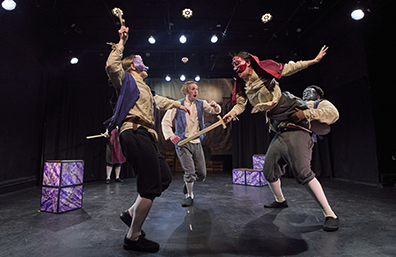
The "Montague Cast" Mercutio (Mary Myers, left) fights with an elevated Tybalt (Francesca Chilcote) as Romeo (Max Johnson, center) tries to intervene in Faction of Fools' production of A Commedia Romeo and Juliet at the Washington, D.C., Capitol Hill Arts Workshop. Others participating in the fray are a servant (Jasmine Proctor, back) and Benvolio (Deimoni Brewington) lifting Tybalt. Photo by DJ Corey Photography.
Commedia’s slapstick traditions actually amp up the play’s emotional impact. In the famous balcony scene, distilled of its tradition-saddled tropes, Romeo and Juliet talk to the audience but listen to each other, heightening their intensity as they navigate their first experience with true love. The dreary “oh woe” scene of Juliet’s fake death becomes a comic set piece, a literal joke carried out by Friar Laurence. Mercutio’s death—in which the character sets down his mask leaving an inanimate face on the stage—is powerfully moving after all the comic shenanigans preceding it. Romeo and Juliet is a tragedy, after all, and Wilson deftly sprung its tragic elements onto a laughing audience—which may have been Shakespeare’s intent (several directors have staged the Mercutio-Tybalt fight for laughs, including Franco Zeffirelli in his 1968 film). Romeo’s ferocious murder of Tybalt, on the other hand, has not an iota of humor in it.
With Wilson since retired, directing the remount is Kathryn Zoerb, Faction of Fools co-artistic director, a title she shares with Francesca Chilcote, who plays Friar Laurence, Tybalt, and Lady Capulet in the Montague Cast. Zoerb has been a Fool since 2015, and in addition to Wilson’s mentoring, she studied commedia dell’arte at the Accademia dell’Arte in Arezzo, Italy, and further studied under Maestro Antonio Fava. She’s also a notable Shakespearean actor in Capital Region theaters, including the Folger. She and Assistant Director Matthew Pauli, another veteran Fool, made further adaptations to the script “with care and flexibility as opposed to rebuilding a rigid reconstruction of the past,” Zoerb writes in her program notes. “We took care to maintain what was timeless and rehearse with flexibility to adapt to our new actors and design team, whether that was in new mask design, actor interpretation, physical character building, or pedagogy.”
Two script changes are key examples of pedagogical considerations, commedia and Shakespearean. In the original, Mercutio (Paul Reisman) spoke his last line, “Your houses!” after removing his mask and placing it on the stage. Zoerb explained in a Shakespeareances.com interview that the player is a character in a mask but a narrator when maskless (unless playing a lover). The character speaks the line, so her Mercutios (Robert Pike for the Capulet Cast, Mary Myers for the Montague Cast) say “Your houses!” before removing the mask and departing. Though Pike's and Myers' timing are technically correct, I shudder more at my memory of Reisman’s interpretation.
Zoerb's other seemingly slight but significant script change is grounded in Shakespeare’s text. In Wilson’s original, Tybalt remains on stage, saddened by Mercutio’s death; Romeo’s killing him comes across as needlessly brutal. Zoerb’s version, in keeping with Shakespeare's direction, has Tybalt leave and return explicitly to fight Romeo. Romeo dispatches Tybalt with such speed it elicits gasps among the audience while underpinning Romeo’s heartbreak as he laments, “O, I am fortune’s fool!” Mercutio’s death marks the point when Romeo and Juliet turns from comedy to tragedy, but it's Romeo’s rash violence in a millisecond that initiates the fateful path leading to his and Juliet’s tragic ending. Zoerb’s version of the Romeo-Tybalt fight with minimum choreography pronounces that impact with a power I’ve not seen or felt in three dozen previous stagings of Shakespeare’s play, including the original Faction of Fools version.
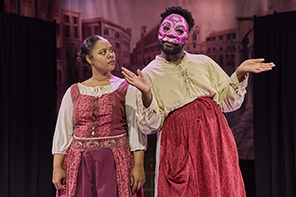
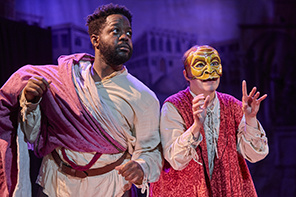 Top, Deimoni Brewington as Nurse with Juliet (Jasmine Proctor), and, above, as Paris with Capulet (Mary Myers) in the Faction of Fools production of A Commedia Romeo and Juliet. Photos by DJ Corey Photography.
Top, Deimoni Brewington as Nurse with Juliet (Jasmine Proctor), and, above, as Paris with Capulet (Mary Myers) in the Faction of Fools production of A Commedia Romeo and Juliet. Photos by DJ Corey Photography.
The two casts display different textures that actors bring to archetypal stock figures as well as Shakespeare’s well-drawn characters. One exception is Paris, as both Ben Lauer of the Capulet Cast and Deimoni Brewington of the Montague Cast play him as an arrogant jerk, “lover” though he may be. These two actors also play Nurse and Benvolio, and both achieve big laughs in the “Oh Woe” scene switching back and forth between Paris and Nurse, which, in addition to putting on and taking off Nurse’s mask involves turning Nurse’s apron and dress inside out to create a cape across Paris’s arm (Lynly A. Saunders was costume designer for the original and the remount).
Differences in portrayals of the titular lovers may be due more to skill sets than interpretation. Travis Xavier Brown, the Capulet Romeo, has plenty of Shakespeare experience in his bio and derives his character from the playwright’s textual subtleties, including a nice discovery when Juliet worries that he will be killed if her kinsmen find him outside her window. “With love's light wings did I o'er-perch these walls,” Romeo says, “And what love can do that dares love attempt; Therefore, thy kinsmen are no stop to me” (the second line in this four-line speech has been excised). Brown says this with a confident swagger that comes off as naively sweet rather than macho boasting or romantic posturing.
Bri Houtman, the Capulet Juliet, has little Shakespeare experience but brings to her role a full-hearted portrayal of a teen-ager discovering what love feels like. Her matter-of-fact readings are revelations. “How stands your disposition to be married?” asks Lady Capulet (Natalie Cutcher in this cast). “It is an honor that I dream not of,” Juliet replies in a teen girl's disinterested “never entered my mind” tone, earning an 8-on-10-scale laugh. Her famous opening line in the balcony scene, “O Romeo, Romeo! Wherefore art thou Romeo,” is extrametrical, and Houtman shifts the added emphasis to a surprising but perfectly suitable word: thou. “Wherefore art THOU Romeo,” as in, “How can a Montague be SO cute?!”
In the lovers’ first meeting, Houtman and Brown take an insightful approach to the come-ons that is their shared sonnet. When Juliet picks up with the second quatrain, rather than playing the good girl card by trying to dissuade Romeo, Houtman uses subtle emphasis to turn her reply into a hint for Romeo to kiss her for real. He picks up the hint and they sonnet their way to not just one kiss but the second one, too, with Juliet again pointing the way. Her closing line, “You kiss by the book,” is in appreciation of Romeo following her improvised script.
In the Montague Cast, Jasmine Proctor’s more nuanced performance surfaces Juliet’s intelligence and maturity in Shakespeare’s lines. She and Brown would make a mesmerizing couple in a traditional Romeo and Juliet production, but in commedia dell’arte, Proctor's Juliet is overlooked—literally by her Romeo, Max Johnson. His over-the-top performance (again, literally) has Romeo ever dreaming on love in some distant cloud and ever posing like a ballet dancer expressing romantic airs, whether standing, sitting, or climbing balconies (but not when fighting Tybalt). Ironically, the more Shakespearean Proctor has only one Shakespeare production in her bio but a couple of Faction of Fools productions under her belt; Johnson playing the more archetypal lover is making his Faction of Fools debut but is a teaching artist with the Shakespeare Theatre Company.
How the two Romeos carry out their parting scene with Juliet is instructive of their styles. The production—or maybe Shakespeare himself—applies a common commedia trope to this scene, repeating a joke that gets funnier with each telling until the audience tires of it: the goal is to take the joke one step before too far. Romeo departs from Juliet’s window four times, only to have her continue their conversation each time. Brown’s Romeo mimes climbing down the tower, scooting under a gate, and stalking off, but each time stopping, returning under the gate and up the tower, with ever increasing notes of exasperation accompanying each return to Juliet. Johnson’s Romeo doesn’t have a gate to scoot under, but he has a distant love cloud to keep his eye on as he mimes climbing down the tower and parading off. He doesn’t show exasperation with each return, but he does have a harder time focusing on that cloud.
The final scene is played entirely for laughs despite the climactic double suicide at its center. Romeo carrying a crowbar and Paris carrying a bouquet of flowers enter the Capulet’s crypt separately with their servants; the servants get confused in the darkness, so Romeo ends up with the flowers and Paris with the crowbar. Romeo uses his knife to kill Paris, so Juliet pulls it from Paris’s belly, much to the corpse’s discomfort. Because the actors playing Juliet, Romeo, and Paris are doubling as, respectively, the Prince, Montague, and Nurse, their bodies are replaced by dummies that the living characters toss to each other around the stage during Friar Laurence’s overlong exposition speech, as they did Juliet's real body in the overlong "Oh woe!" scene. Wilson followed by Zoerb nevertheless managed to bring the tragedy’s thematic purpose to its intended end by returning Romeo and Juliet to the stage for a coda dance capsulizing their heartbreaking journey. With all three casts, this moment seals the play’s heartbreak amid a vision of hoped-for peace.
One key performer from the 2012 production makes a reappearance in the remount. At the play's opening, the casts enter as a traditional commedia troupe riding a trunk on wheels. The troupe greets us with a shout and begin speaking the play’s opening Chorus, each of the five cast members taking on different verses in the speech (changing "two-hours traffic" to "one-hour's traffic") as they open the trunk and remove masks and other props. The trunk remains on stage through the first two scenes, but at the start of the third scene introducing Juliet, the cast dismantles the trunk into sections serving as building blocks for stage sets: the balcony, seats on the plaza, a confessional, a cross, and a skateboard. The individual squares are wood on two sides and painted as marble on the other two sides. Some sections further serve as cabinets for more masks and props. The audience gasps with delight seeing the trunk dismantled into magical versatility; after all, the cast had pulled items out of the trunk during the chorus, so how did they do that? After the original Commedia Romeo and Juliet, Faction of Fools held on to the trunk, designed by Daniel Flint. Its magic endures, like that of the entire production, Shakespeare, and commedia dell’arte.
Eric Minton
February 18, 2024
Comment: e-mail editorial@shakespeareances.com
Start a discussion in the Bardroom



 Find additional Shakespeareances
Find additional Shakespeareances